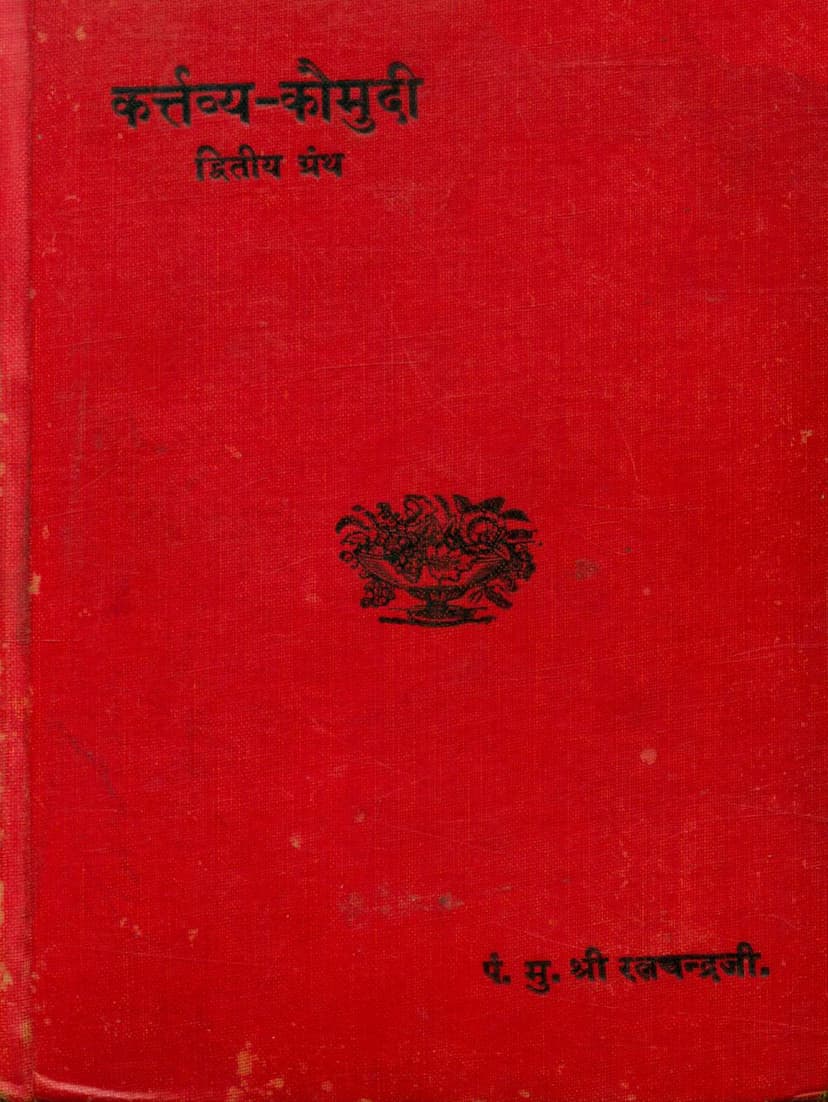Karttavya Kaumud Dwitiya Granth
Added to library: September 2, 2025

Summary
Summary of "Karttavya Kaumud Dwitiya Granth"
"Karttavya Kaumud Dwitiya Granth" (Duty Moonbeam, Second Volume) is a Jain text authored by Shatavdhani Pandit Muniraj Shri Ratnachandji and published by Chunilal Vardhman Shah. This second volume, comprising two parts, focuses on the duties and responsibilities associated with the latter two stages of life as outlined in traditional Indian philosophy: Vanaprasthashram (Retirement to the Forest) and Sanyasashram (Renunciation).
The first volume of this work covered the duties pertaining to the first two stages: Brahmacharya (Student Life) and Grihasthashram (Family Life). This second volume, in its entirety, addresses the principles of detachment and spiritual pursuit necessary for the final two stages of life.
Key Themes and Content:
The book is structured into two main parts, each containing several chapters, covering a wide range of ethical, spiritual, and practical guidance for the later stages of life, with a strong emphasis on Jain principles.
Part 1: Focus on Retirement and Service
This section deals with the transition from active life to a more withdrawn and service-oriented existence. Key areas covered include:
- Samyakdrishti (Right Perception): Emphasizing the importance of correct understanding of the three jewels of Jainism: Right Faith (Samyak Darshan), Right Knowledge (Samyak Gyan), and Right Conduct (Samyak Charitra). This is the foundational aspect for all religious practices.
- Samya Charitra (Right Conduct) and Vratas (Vows): Elaborates on the practice of vows, both major (Mahavrata) and minor (Anuvrata). It details the importance of adhering to these vows, drawing examples from figures like Anand Shravak and King Kumarpal.
- Ahimsa Vrat (Non-violence): Discusses the multifaceted nature of non-violence, extending beyond physical harm to mental and verbal non-violence. It emphasizes the avoidance of unnecessary harm to all living beings, including subtle forms of violence.
- Satya Vrat (Truthfulness): Explores the nuances of truthfulness, highlighting the importance of speaking what is beneficial and truthful, avoiding harsh or misleading speech. Examples illustrate how even well-intentioned untruths can lead to unintended consequences.
- Asteya Vrat (Non-stealing): Defines stealing broadly, encompassing not just the physical act but also the intention and encouragement of it, including the acceptance of ill-gotten gains.
- Brahmacharya Vrat (Celibacy/Chastity): Discusses the importance of controlling sensual desires and maintaining purity in thought, word, and deed. It emphasizes self-control and the detrimental effects of succumbing to passions.
- Parigrah Pariman Vrat (Non-possession/Limited Accumulation): Advocates for controlling desires and limiting possessions to what is essential for sustenance, warning against the accumulation of wealth and its associated attachments.
- Dishan Vrat (Control of directions) & Bhogopabhog Vrat (Control of consumable items): These sections focus on limiting one's movement and consumption, reducing attachment to worldly possessions and experiences.
- Anarthadand Virati Vrat (Abstinence from useless activities): This vow addresses the avoidance of harmful or pointless actions, including negative thoughts (Ap-dhyana), negligence (Pramad), possession of weapons, and instigating others to sin.
- Samayik Vrat (Equanimity/Meditation): Highlights the practice of maintaining mental equanimity and engaging in meditation for spiritual purification and self-realization.
- Service to Humanity (Seva Dharma): A significant portion of the first part is dedicated to the concept of service, framing it as a way to repay societal debts and achieve spiritual growth. It outlines various forms of service, including:
- Universal Love (Maitri, Promod, Karuna, Upeksha): Cultivating positive attitudes towards equals, superiors, inferiors, and even adversaries.
- Service to Children: Emphasizing the need for childcare and education, particularly for orphans.
- Service to the Poor and Needy: Providing financial, material, and emotional support.
- Service to the Sick: Caring for the unwell, offering comfort and medical aid.
- Service to the Elderly: Respecting and caring for elders.
- Service to Animals: Advocating for compassion and protection of all living beings.
- Community Service: Engaging in activities that benefit the larger society.
- Family Service: Fulfilling duties towards one's own family.
Part 2: Focus on Renunciation and Inner Purity
This section delves into the principles and practices of renunciation and advanced spiritual disciplines. Key areas covered include:
- Renunciation (Sanyas): Discusses the transition to a renunciate life, emphasizing the abandonment of worldly desires and the pursuit of spiritual knowledge.
- Vairagya (Detachment): Explores the development of detachment from worldly pleasures and attachments, outlining different levels and motivations for detachment (from suffering, attachment, and through knowledge).
- Mahaavrata and Papasthan Parihar (Major Vows and Avoidance of Sins): Elaborates on the major vows and the critical importance of renouncing all forms of sin.
- Samitis (Right Conduct in Movement) and Guptis (Restraint): Details the specific rules of conduct for monks and ascetics concerning movement, speech, and thought.
- Parishaha Vijaya (Conquest of Hardships): Focuses on the practice of enduring hardships and adversions with equanimity and inner strength.
- Sadhu's Daily Routine: Outlines the prescribed daily activities and disciplines for monks.
- Tapascharya (Austerities): This extensive section covers various forms of ascetic practices:
- Abstinence (Anashana): Fasting and other forms of food restriction.
- Swadhyaya (Self-study): The importance of studying scriptures and reflecting on their meaning.
- Dhyana (Meditation): The practice of concentrating the mind on spiritual truths and the divine.
- Vyutsarga (Abandonment of the Body): A profound practice of detaching oneself from the physical body and its sensations.
Overall Purpose:
The "Karttavya Kaumud Dwitiya Granth" serves as a comprehensive guide for individuals entering the later stages of life, encouraging them to shift their focus from worldly pursuits to spiritual development, service, and detachment. It emphasizes the Jain path towards liberation (Moksha) through the rigorous practice of ethical conduct, self-discipline, and unwavering devotion to spiritual knowledge. The book aims to provide practical guidance on how to live a meaningful and purposeful life, even in the face of worldly challenges, ultimately leading towards ultimate liberation.